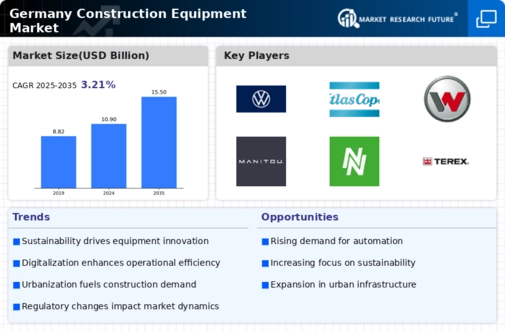Urbanization Trends
Urbanization in Germany is a significant driver for the construction equipment market. As urban areas expand, the demand for residential and commercial buildings increases, necessitating the use of advanced construction machinery. Reports indicate that urban populations in Germany are projected to rise by 5% over the next decade, leading to a heightened need for construction activities. This trend compels construction companies to invest in modern equipment to meet the growing demands of urban development. Additionally, the construction equipment market is likely to see a shift towards compact and efficient machinery that can operate in densely populated areas, further influencing purchasing decisions and market dynamics.
Infrastructure Investment Surge
The construction equipment market in Germany is currently experiencing a notable surge in infrastructure investments. The German government has allocated approximately €10 billion for infrastructure projects, which is expected to stimulate demand for construction equipment. This influx of funding is likely to enhance the construction sector's growth, as municipalities and private developers embark on various projects, including road construction, bridge repairs, and urban development. Consequently, the construction equipment market is poised to benefit from increased procurement of machinery and tools necessary for these large-scale projects. Furthermore, the emphasis on modernizing existing infrastructure may lead to a shift towards advanced equipment, thereby driving innovation within the construction equipment market.
Increased Demand for Rental Equipment
The construction equipment market in Germany is experiencing a notable shift towards rental services. As construction companies seek to optimize costs and improve flexibility, the demand for rental equipment is on the rise. This trend is particularly evident among small to medium-sized enterprises that may not have the capital to invest in purchasing new machinery. The rental market is projected to grow by approximately 7% annually, indicating a robust shift in how construction companies approach equipment acquisition. Consequently, this trend is likely to influence the construction equipment market, as rental service providers expand their fleets to meet the increasing demand for diverse and specialized machinery.
Technological Advancements in Equipment
The construction equipment market in Germany is significantly influenced by ongoing technological advancements. Innovations such as automation, telematics, and electric machinery are reshaping the landscape of construction operations. For instance, the integration of telematics systems allows for real-time monitoring of equipment performance, enhancing efficiency and reducing operational costs. Furthermore, the shift towards electric construction equipment is gaining traction, driven by environmental regulations and the need for sustainable practices. As a result, manufacturers are increasingly focusing on developing advanced machinery that meets these evolving standards, thereby propelling growth within the construction equipment market.
Regulatory Compliance and Safety Standards
Regulatory compliance and safety standards play a crucial role in shaping the construction equipment market in Germany. The government has implemented stringent regulations aimed at ensuring safety and environmental sustainability in construction practices. Compliance with these regulations often necessitates the acquisition of modern equipment that meets safety standards, thereby driving demand within the market. Additionally, companies that prioritize safety are likely to invest in advanced machinery equipped with safety features, further influencing purchasing trends. As a result, the construction equipment market is expected to witness a shift towards safer and more compliant machinery, reflecting the industry's commitment to adhering to regulatory requirements.
























Leave a Comment